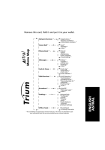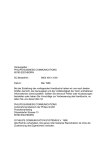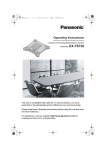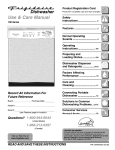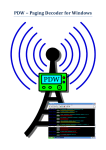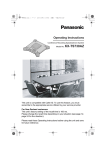Download Sophos D340 User's Manual
Transcript
USER GUIDE
SOPHO
ErgoLine D340
A Publication of
PHILIPS BUSINESS COMMUNICATIONS
HILVERSUM, THE NETHERLANDS
Order No.:
9504 404 17203
Manual No.:
Date:
June 2005
Great care has been taken to ensure that the information
contained in this handbook is accurate and complete.
Should any errors or omissions be discovered or should any
user wish to make a suggestion for improving this handbook,
they are invited to send the relevant details to :
PHILIPS BUSINESS COMMUNICATIONS
CUSTOMER SERVICES
P.O. BOX 32
1200 JD HILVERSUM
THE NETHERLANDS
© PHILIPS COMMUNICATION SYSTEMS B.V. 2005
All right are reserved. Reproduction in whole or in part is
prohibited without the written consent of the copyright owner.
All brand names and product names in this document are
trademarks or registered trademarks of their respective companies.
Contents
Section 1 Introduction
Introducing the SOPHO ErgoLine D340 ...........................................................1
How to use the Help key....................................................................................1
SOPHO ErgoLine D340 Terminal Layout .........................................................2
Section 2 Making and answering a call
Making calls
Dialling a number.............................................................................................3
Dialling hands-free ...........................................................................................3
Dialling a number offline..................................................................................4
Dialling using a speed-dial key .........................................................................4
Dialling someone using the directory or the extra phonebook(s)........................5
Using the Callers list.........................................................................................6
Switching between Listen-in, Hands-free and Soft speaking
Switching from Soft speaking to Listen-in ........................................................7
Switching from Soft speaking to Hands-free......................................................7
Switching from Hands-free to Listen-in ............................................................7
Switching from Hands-free to Soft speaking......................................................8
Switching from Listen-in to Soft speaking ........................................................8
Switching from Listen-in to Hands-free ............................................................8
Switching the active microphone off and on
Switching the active microphone off and on......................................................9
Contents
i
Using Hold
Putting the caller on Hold and calling someone else ........................................10
Transferring a call ..........................................................................................10
Shuttling between two calls.............................................................................11
Connecting to a held call and disconnecting a current call ..............................11
Connecting to a held call after being disconnected ..........................................11
Setting up a three party conference..................................................................12
Answering and ending a call
Answering an incoming call ...........................................................................13
Answering a diverted call................................................................................13
Ending a call...................................................................................................14
Using the last number redial
Calling someone from the Redial list...............................................................15
Removing a number from the Redial list .........................................................15
Editing a number from the Redial list .............................................................16
Dialling a number from the Redial list during a call........................................16
Adding the number of a connected party to the Redial list ...............................17
Things you can do if the line is busy or not answered
Calling back a busy number or a not answering number..................................18
Cancelling a Callback .....................................................................................18
Things you can do if the line is busy
Intruding on a busy line ..................................................................................19
Waiting for a busy extension ...........................................................................19
ii
Contents
Answering incoming call waiting
Switching between the current call and a waiting incoming call......................20
Putting the current call on hold and answering an incoming call.....................21
Ending the current call and answering call waiting.........................................21
Disconnecting a call and making another call whilst a caller waits..................22
Answering incoming call waiting whilst programming the telephone..............22
Answering a waiting message
Calling in a waiting message ..........................................................................23
Preparing a number during a call
Preparing a number during a call ....................................................................24
Section 3 Administrative functions
Monitoring the costs and duration of calls
Monitoring cost and call duration ...................................................................25
Monitoring total costs during a certain period .................................................25
Using the personal directory
Adding a name to the directory.......................................................................26
Removing a name from the directory ..............................................................27
Modifying a name in the directory ..................................................................28
Copying an entry from the extra books to the personal directory......................29
Sending and receiving messages
Sending a message..........................................................................................30
Reading a message during a call .....................................................................31
Creating, editing and activating a notice .........................................................31
Cancelling a notice .........................................................................................32
Contents
iii
Diverting calls
Diverting calls to a specific extension .............................................................33
Preparing your telephone for diverting calls ....................................................34
Diverting calls from another phone to your phone...........................................35
Deactivating diversion of your calls from your phone ......................................36
Deactivating diversion of your calls from another phone .................................36
Section 4 Customising your telephone
Toggling features on and off
Toggling features on and off ...........................................................................37
Changing specific telephone settings
Changing the contrast of your display .............................................................39
Changing the language of your terminal .........................................................40
Adjusting the ringer volume on your telephone ...............................................41
Adjusting the ringer melody on your telephone ...............................................42
Locking the telephone
Locking the telephone.....................................................................................43
Unlocking the telephone .................................................................................44
Changing your password to set the lock...........................................................45
Setting the voice output medium
Setting the voice output medium .....................................................................46
iv
Contents
Using Special mode
Entering Special mode ....................................................................................47
Clearing all personal information (keys, directory, messages) .........................48
Downloading features to your telephone..........................................................50
How to return to User mode ............................................................................51
Alphanumeric keyboard
Setting the alphanumeric keyboard module .....................................................52
Entering special characters on the alphanumeric keyboard..............................54
Entering capital letters using the alphanumeric keyboard................................55
Preparing a list of free messages
Preparing a list of free messages .....................................................................56
Setting up and using memory keys
Programming a speed dial number into an empty memory key........................57
Programming a function in an empty memory key ..........................................58
Programming a group facility in an empty memory key ..................................60
Editing the contents of a memory key..............................................................62
Emptying the contents of a memory key..........................................................63
Using a function key to activate or deactivate a function .................................64
Using a speed dial key during a call ................................................................64
Contents
v
Section 5 Using Group functions
How to use Group features
Using group facilities ...................................................................................65
Monitoring the status of group facility keys ..................................................66
Making a call to a groupmember ..................................................................67
Making an intercom call to a groupmember .................................................68
Answering an incoming call for a groupmember ..........................................69
Answering an incoming call from a groupmember .......................................69
Toggling your telephone between absent and present....................................70
Switching your telephone absent for incoming group calls............................71
Remotely toggling another telephone between absent and present.................72
Answering calls for the executive .................................................................73
Answering group calls, private calls or personal calls...................................74
Parking and unparking a call........................................................................75
Using an alternative secretary.......................................................................76
How to observe the group status ...................................................................77
Glossary
vi
Contents
Introducing the SOPHO ErgoLine D340
The SOPHO ErgoLine D340 telephone combines modern styling with sophisticated, easyto-use functionality. The ErgoLine range is designed to release the full power of the
Philips iS3000 system.
The following Ergoline options offer you increased flexibility:
• Direct Station Select (DSS) module
Each DSS module gives you an
additional 14 programmable keys. You can
attach up to 3 DSS modules.
• Infra-red Alphanumeric Keyboard
(optional)
Makes data entry easier. It also enables
you to control your terminal remotely.
• PC interface
Enables you to control your terminal
from your P.C. via a TAPI interface.
• line interfaces
The set is factory fitted with a 4-wire or 2wire terminal interface card.
How to use the Help key
?
1 Press the Help key to get Help on specific
softkeys or fixed functionkeys
Directory
e.g.
or
?
2 Press the fixed function key or softkey
in any situation and read the display
3 Press the Help key again to switch off
Help
Introducing the SOPHO ErgoLine D340
1
623+2(UJR/LQH'WHOHSKRQHOD\RXW
ErgoLine
6RIWNH\V
%DFNVSDFH
9ROXPH
+ROG
OK
/RXGVSHDNHU
6KLIW
0LFPXWH
$%&
/15
([LW
'()
*+,
-./
012
3456
789
:;<=
+HOS
0HPRU\NH\V
6SHFLDOFKDU
NH\
2.NH\
623+2(UJR/LQH'7HOHSKRQH/D\RXW
Dialling a number
1
Lift the handset
2
Type the number you want
Dialling handsfree
1
Press the Loudspeaker key
2
Type the number you want
Making calls
3
Dialling a number offline
1
Type the number you want
2
Either lift the handset, press the
Loudspeaker key, or press OK
or OK
or
Dialling using a speed-dial key
Before you can dial someone using a speed-dial key, it must be programmed with
the number you are dialling (see Programming a speed-dial number into an empty
memory key in section 4)
1
Lift the handset or press the
Loudspeaker key
2
Press the speed-dial key you want
or
or
+
or
Press Shift and the speed-dial key to
access the second level
Note: If ‘one keystroke call’ setup is active (see Toggling features on and off in
section 4). you only have to press the speed-dial key. The call is then set up
automatically.
4
Making calls
Dialling someone using the personal directory or the
extra phonebook(s)
The directory, often called personal directory, is present in your terminal. Before you
can dial someone using the directory, you must have a directory set up with names
and numbers (see Adding a name to the directory). It can contain up to 100 names.
An extra phonebook consists of names/numbers, present in the system e.g. a list of the
employees in the company. An extra phonebook is not always present, this depends
on the system.
PhoneBook
Directory
1
or
Press the directory softkey or the phonebook
softkey.
If you have a phonebook softkey, select the
phonebook you want to access by pressing the
related softkey
2
Key the first letter of the name you are calling:
(for example, to enter B press number key 2
twice)
<
Alternatively, you can use the optional
alphanumeric keyboard if you have one
<
OK
3
Scroll if necessary to find the name you want
4
Press OK to see the number
5
Either lift the handset, press the Loudspeaker
key, or press OK
<
<
OK
or
or OK
Making calls
5
Using the Callers list
During your absence callers numbers and/or messages, plus the date and time of the call,
are stored into the Callers list in your phone. The Callers list can contain 15 callers
numbers and/or messages.
Message
1
The Message softkey flashes to indicate a new
caller in the Callers list. Press the Message
softkey
Callers
2
Press the Callers softkey. The list of callers appears
in the display
Note: The display shows the time and date that the
call was received and the name of the caller if they
are a member in your directory
3
<
<
OK
<
<
Note: Once you have viewed all the callers in
the list, the message softkey stops flashing
ReadMsg.
4
To read a message from a caller, press the
ReadMsg softkey
Remove
5
To remove a caller from the Callers list, press
the Remove softkey
6
To call a person from the Callers list, lift the
handset, press OK or press the loudspeaker key
or OK or
6
Scroll to see all the callers in the list
Making calls
Switching from Softspeaking to Listen-in
Press the Loudspeaker key whilst using the handset
Switching from Softspeaking to Handsfree
Press and hold down the Loudspeaker key, replacing
the handset whilst the prompt is displayed
+
Note: If you release the loudspeaker key and then
replace the handset you will disconnect your call.
Switching from Handsfree to Listen-in
1
Lift the handset
2
Press the Loudspeaker key
Switching between Listen-in, Handsfree and Softspeaking
7
Switching from Handsfree to Softspeaking
Lift the handset
Switching from Listen-in to Softspeaking
Press the Loudspeaker key to deselect Listen-in
Switching from Listen-in to Handsfree
+
To switch from Listen-in to Handsfree, hold down
the Loudspeaker key and replace the handset
Note: If you release the loudspeaker key and then
replace the handset you will disconnect your call
8
Switching between Listen-in, Handsfree and Softspeaking
Switching the active microphone off and on
Note: The same Mic key is used for both the handset and handsfree microphones.
Press the Microphone mute key to switch the
active microphone off. Press the Microphone mute
key again to switch it back on
Note: If Microphone mute is on, the other party cannot hear you. The LED indicates the
status of the microphone, as follows:
LED off
The handset microphone is on as you are using the handset, or the set is
idle.
LED flashing
The microphone is off: the other party cannot hear you.
LED on
The handsfree microphone is on: you are using the telephone
handsfree.
Switching the active microphone OFF and ON
9
Putting the caller on Hold and calling someone else
R
R
1
Whilst connected, press the Hold key
2
Dial the number of the other party
3
Press the Hold key again to return to the original
caller
Transferring a call
R
Whilst connected, press the Hold key
Dial the number of the other caller
Replace the handset or, if using the telephone
handsfree, press the Loudspeaker key
or
10
Using Hold
Shuttling between two calls
R
1
Whilst connected to one caller with a second caller
on Hold, press the Hold key. You are connected to
the held call and the original caller is put on Hold
R
2
Press the Hold key again to connect to the original
caller and put the second caller on Hold
Connecting to a held call and disconnecting a current call
Reconnect
To connect to the person who is on Hold and disconnect the
current call, press the Reconnect softkey
The duration and costs of the call if available are displayed
Connecting to a held call after being disconnected
R
Press the Hold key or replace the handset
or
If you replace the handset, the telephone rings and you can
answer it in the normal way
Using Hold
11
Setting up a three-party conference
It may be that your system does not support this feature for you. If that is the case, you will
not have access to it.
R
1
Whilst connected to one caller, press the Hold
key
Prep3Call
2
Press the Prep3Call softkey
3
Dial the number of the third party
4
To start the three-party conference, press the
3-Call softkey
5
To see the i.d. of the third connected party, press
the ViewParty softkey
6
To withdraw from the call, either replace the
handset, or to use the telephone handsfree press
the Loudspeaker key, or press OK
3-Call
ViewParty
3-Call
or
or
OK
The other two parties can continue their
conversation after you have disconnected
12
Using Hold
$QVZHULQJDQLQFRPLQJFDOO
RU
(LWKHUOLIWWKHKDQGVHWRULIXVLQJWKHWHOHSKRQH
KDQGVIUHHRUSUHVVWKH/RXGVSHDNHUNH\
$QVZHULQJDGLYHUWHGFDOO
7KHFDOOLVGLYHUWHGWR\RXWKHPRPHQW\RXVHHWKHQDPHRUQXPEHURIWKHRULJLQDOO\
GLDOOHGSHUVRQLQWKHWRSOLQHRIWKHGLVSOD\
7KHQDPHQXPEHURIWKHRULJLQDOO\GLDOOHGSDUW\FDQEHDFFRPSDQLHGE\DQ
LQGLFDWLRQEHWZHHQEUDFNHWVRIWKHUHDVRQZK\WKHFDOOLVGLYHUWHGWR\RX
WKHSHUVRQLVEXV\LQDQRWKHUFDOO
WKHSHUVRQGRHVQ¶WDQVZHUWKHSKRQH
WKHSHUVRQFDQQRWEHUHDFKHG
WKHSHUVRQLVDEVHQW
7KHQDPHDQGRUQXPEHURIWKHFDOOLQJSDUW\FDQEHDFFRPSDQLHGZLWKD%LFRQ
7KLVPHDQVWKDWWKHFDOOHUKDVEHHQZDLWLQJLQDTXHXHIRUDZKLOH
/LIWWKHKDQGVHWRUSUHVVWKH/RXGVSHDNHUNH\
RU
$QVZHULQJDQGHQGLQJDFDOO
Ending a call
1 Replace the handset or, if using the telephone
handsfree, press the Disconn softkey or the
Loudspeaker key
or
Disconn
If you replace the handset, the duration and
costs of the call if available are displayed
or
Note: If the phone starts ringing after you have
ended the call, there is a call waiting. This is
announced as a normal incoming call
or
14
or OK
2 Lift the handset, press the loudspeaker key, or
press OK to answer this next call
Answering and ending a call
Calling someone from the Redial list
<
Every time you make a call the number you call is stored in the Redial list. This list
can contain 10 numbers.
<
OK
1
Press the Redial key
2
Scroll to find the number you want to call
3
Either lift the handset, or if using the telephone
handsfree press the Loudspeaker key, or press
OK.
<
<
or
or
OK
Any currently connected party is put on Hold
automatically
Removing a number from the Redial list
Remove
1
Press the Redial key
2
Scroll to the number you want to remove
3
Press the Remove softkey
4
To return to idle, press the Exit key
Using the last number redial
15
<
Editing a number from the Redial list
<
OK
1
Press the Redial key
2
Scroll to the number you want to edit
3
Edit the number using the number keypad and
the backspace key
4
To dial the number, either lift the handset,
or, if using the telephone handsfree press
the Loudspeaker key, or press OK
<
<
X
or
or
OK
The number is now stored in the Redial list
<
Dialling a number from the Redial list during a call
<
OK
1
During a call, press the Redial key
2
Scroll to the number you want to dial
3
Press OK.
<
<
OK
The connected party is put on Hold and the
number is dialled
16
Using the last number redial
$GGLQJWKHQXPEHURIDFRQQHFWHGSDUW\WRWKH5HGLDOOLVW
<
<
OK
<
7KH6WRUH1PEURSWLRQLVGLVSOD\HG
<
StoreNmbr
'XULQJDFDOOVFUROOULJKW
3UHVVWKH6WRUH1PEUVRIWNH\
7KHQXPEHULVQRZVWRUHGLQWKH5HGLDOOLVW
8VLQJWKHODVWQXPEHUUHGLDO
&DOOLQJEDFNDEXV\QXPEHURUDQRWDQVZHULQJQXPEHU
,WPD\EHWKDW\RXUV\VWHPGRHVQRWVXSSRUWWKLVIHDWXUHIRU\RX,IWKDWLVWKHFDVH
\RXZLOOQRWKDYHDFFHVVWRLW
CallBack
2QKHDULQJWKHEXV\WRQHRULIWKHUHLVQR
DQVZHUSUHVVWKH&DOO%DFNVRIWNH\
5HSODFHWKHKDQGVHWLI\RXDUHXVLQJLW
:KHQWKHEXV\QXPEHUEHFRPHVDYDLODEOHRU
WKHQRWDQVZHULQJH[WHQVLRQZDVXVHG\RXU
WHOHSKRQHZLOOULQJLQDGLIIHUHQWWRQHDQGWKH
&DOOEDFNWRSURPSWZLOOIODVKLQWKHGLVSOD\
RU 2.
RU
6WDUWWKHFDOOEDFNFDOOE\HLWKHUOLIWLQJWKH
KDQGVHWSUHVVLQJWKH/RXGVSHDNHUNH\RU
SUHVVLQJ2.
&DQFHOOLQJD&DOOEDFN
<
,WPD\EHWKDW\RXUV\VWHPGRHVQRWVXSSRUWWKLVIHDWXUHIRU\RX,IWKDWLVWKHFDVH
\RXZLOOQRWKDYHDFFHVVWRLW
<
OK
3UHVVWKH5LJKW$UURZNH\WRGLVSOD\WKH
VHFRQGVHWRIVRIWNH\V
3UHVVWKH'HO&DOOEVRIWNH\
<
<
Del.Callb
$OORXWVWDQGLQJFDOOVEDFNDUHFDQFHOOHG
7KLQJV\RXFDQGRLIWKHOLQHLVEXV\RUQRWDQVZHUHG
,QWUXGLQJRQDEXV\OLQH
Intrude
3UHVVWKH,QWUXGHVRIWNH\
1RWH%RWKSDUWLHVFDQKHDU\RXZKHQ\RXGRWKLV
:DLWLQJIRUDEXV\H[WHQVLRQ
I’llWait
3UHVVWKH,¶OO:DLWVRIWNH\
1RWH$PHVVDJHDSSHDUVLQWKHGLVSOD\WHOOLQJ\RX
ZKHUH\RXDUHLQWKHTXHXHWRWKHUHFLSLHQW
:DLWIRUWKHFDOOWREHDQVZHUHGDQGSURFHHGDVIRU
DQRUPDOFDOO
7KLQJV\RXFDQGRLIWKHOLQHLVEXV\
Switching between the current call and a waiting incoming call
WhoWaits?
1
Press the WhoWaits? softkey
Answer
2
Whilst the i.d. of the waiting caller is
displayed, press the Answer softkey to swap
to the waiting caller
Note: You are connected to the waiting call
and the original call is now waiting
20
Answering incoming call waiting
Putting the current call on hold and answering an incoming call
If a call waiting comes in you can put the current caller on Hold, before answering the
waiting call
R
1
Press the Hold key
WhoWaits?
2
Press the WhoWaits? softkey
The name of the waiting call appears in the
display
Answer
3
Press the Answer softkey to answer the call
Note: Repeat the steps above to toggle between the two calls
Ending the current call and answering call waiting
1
Replace the handset
Note: If the phone starts ringing, there is a call waiting
This is answered as a normal incoming call as at 2
below
2
or
or OK
Either lift the handset, press the Loudspeaker key, or
press OK
Answering incoming call waiting
21
Disconnecting a call and making another call whilst a caller waits
Disconn.
Directory
1
Press the Disconnect softkey
2
Wait for the dialtone, then enter the number
of the person you want to call or look up their
number in the directory
or
Answering incoming call waiting whilst programming the telephone
1
Press the Exit key to terminate the programming
Note: Only the programming you have carried
out and confirmed by pressing OK, will be saved.
Any previous data saved after pressing OK is
intact
2
or
22
or OK
Answer the incoming call by either lifting the
handset, pressing the Loudspeaker key, or
pressing OK
Answering incoming call waiting
Calling in a waiting message
Before you can use this function, you should program a key with the function: Message
waiting. Then, depending on the kind of message that is waiting, the associated LED is
blinking, flashing or continuously on.
1
Lift the handset or press the Loudspeaker key
2
Press the Waiting Message key
or
Note:
If the LED is still blinking, flashing or on, after you finished calling in a
waiting message, another message is waiting for you. Repeat the above
mentioned steps to call in that message.
Answering a waiting message
23
<
3UHSDULQJDQXPEHUGXULQJDFDOO
<
OK
:KLOVWLQDFDOOSUHVVWKH5LJKW$UURZNH\WR
GLVSOD\WKHVHFRQGVHWRIVRIWNH\V
3UHVVWKH1PEU3UHSVRIWNH\
7\SHWKHQXPEHU\RXZDQW
3UHVV2.WRSXWWKHFDOOHURQKROGDQGGLDOWKH
GLVSOD\HGQXPEHU
<
<
Nmbr.Prep
2.
3UHSDULQJDQXPEHUGXULQJDFDOO
Monitoring cost and call duration
It may be that your system does not support this feature for you. If that is the case, you
will not have access to it.
Call cost and duration are shown in the display at the end of a call
Charge
1
To monitor cost and duration during a call,
press the Charge softkey
Nmbr/Time
2
To switch back to the number information,
press the Nmbr/Time softkey
Monitoring total costs during a certain period
Features
1
Press the Features softkey
<
It may be that your system does not support this feature for you. If that is the case, you
will not have access to it.
2
Scroll right if necessary until Allcosts is
displayed
3
Press the AllCosts softkey
<
OK
<
<
AllCosts
The total costs appear in the display
Restart
Cancel
or
4
To restart the point from which costs are
monitored, press the Restart softkey
Otherwise, press the Cancel softkey to leave
the menu
Monitoring the costs and duration of calls
25
Adding a name to the personal directory
Notes: Names may be added to the directory when the telephone is idle. Also during a
telephone call the name of the B-party may be added to the directory.
This personal directory in your phone can contain up to 100 entries.
Directory
PhoneBook
1
or
Press the Phonebook softkey (if present)
Press the Directory key
Add
2
Press the Add softkey
Note:During a call the number of the connected
party will be displayed.
3
1
2
3
4
5
6
7
8
9
0
#
*
EditNmbr
or
OK
26
Alternatively, you can use the optional
Alphanumeric Keyboard if you have one
.,:!?+-%&/()=¿¡1
ABCàáâãäåæç2
DEFèéêë3
GHIìíîï4
JKL5
MNOñòóôõöœø6
PQRSß7
TUVùúûü8
WXYZ9
space 0
#
*
EditName
Note: International characters can be obtained by
continuous pressing of the key until the character
required is displayed: e.g. to enter à press number 2
four times.
4
or
Type the name: e.g. to enter B press number key 2
twice.
Press the EditName, the EditNmbr softkey or OK
OK
Note: If the name and number displayed are correct,
press OK to save the entry.
5
Type the number
6
Press OK
7
To return to idle, press the Exit key
Using the directory
Removing a name from the directory
Directory
1
Press the Directory softkey
2
Type the first character(s) of the name:
e.g., to enter B press number key 2 twice
<
Alternatively, you can use the optional
Alphanumeric Keyboard if you have one
<
or
3
Press OK, or scroll if necessary to the name
4
Press the Remove softkey
5
To return to idle, press the Exit key
<
<
OK
OK
Remove
Using the directory
27
Modifying a name in the directory
Directory
1
Press the Directory softkey
2
Type the first character(s) of the name: e.g. to enter
B press number key 2 twice
<
Alternatively, you can use the optional
Alphanumeric Keyboard if you have one
<
3
Press OK, or scroll if necessary to the name
4
Press the Modify softkey
5
Modify the name using the number keys and
Backspace or OK if no modifications required
6
Press the EditNmbr softkey or OK if no
modifications required
<
<
OK
OK
or
Modify
X
EditNmbr
or
OK
Note: If OK is pressed, go to step 9
OK
28
7
Modify the number
8
Press OK
9
To return to idle, press the Exit key
Using the directory
Copying an entry from the extra book(s) to the
personal directory
This section is only valid if your system provides the extra phonebook.
PhoneBook
1
Press the phonebook softkey
Select int. book or ext. book by pressing the
appropriate softkey
2
Type the first character(s) of the name: e.g. to enter
B press number key 2 twice
Alternatively, you can use the optional
Alphanumeric Keyboard if you have one
3
<
<
Press OK, or scroll if necessary to the name
<
<
OK
OK
or
Press OK to check the extension number
OK
OK
4
Press OK to check the extension number
5
Press the copy softkey
6
Press OK to copy the item to the personal directory
Using the directory
29
Sending a message
To send a message you must either be connected to someone or their telephone must be
ringing.
Message
1
Press the Message softkey
Any prepared messages appear in the display
<
Note: To enter messages to the list, see
Preparing a list of free messages
<
OK
2
Use the Down Arrow to display the message
you want
3
Edit the message if necessary using Backspace
4
If you want to enter a new message, scroll
down to the first free text line, enter the text
and press OK
5
Press the SendMsg softkey to send the
message to the other party
6
Replace the handset, or press the Loudspeaker
key if in Hands-free mode, when you have
finished
<
<
<
X
<
OK
<
<
and
SendMsg.
or
Note: To be able to receive the message the other party needs to have a similar type of
phone
30
Sending and receiving messages
5HDGLQJDPHVVDJHGXULQJDFDOO
<
,I\RXUHFHLYHDPHVVDJHGXULQJDFDOOWKHPHVVDJHLVGLVSOD\HGLPPHGLDWHO\
<
OK
3UHVVWKHULJKWKDQGVFUROONH\RQFH
3UHVVWKH+LGH0VJVRIWNH\WRVHHWKHQDPHRIWKH
FRQQHFWHGSDUW\DJDLQ
<
<
HideMsg.
3UHVVWKH5HDG0VJVRIWNH\WRVHHWKHPHVVDJH\RX
KDYHUHFHLYHG
ReadMsg.
&UHDWLQJHGLWLQJDQGDFWLYDWLQJDQRWLFH
Message
3UHVVWKH0HVVDJHVRIWNH\
$Q\SUHSDUHGPHVVDJHVDSSHDULQWKHGLVSOD\
<
<
OK
<
6FUROOWRGLVSOD\WKHPHVVDJH\RXZDQWWREHWKH
QRWLFH
<
1RWH,I\RXZDQWWRHQWHUDQHZPHVVDJHVFUROO
GRZQWRWKHILUVWIUHHWH[WOLQHHQWHUWKHWH[WDQGSUHVV
2.
DQG 2.
NoticeTxt
Notice
SwitchOn
Notice
3UHVVWKH1RWLFH7[WVRIWNH\WRVHOHFWWKLVWH[WWREHWKH
QRWLFHWH[W
3UHVVWKH6ZLWFK2QVRIWNH\
1RWH7KHQRWLFHLVVKRZQLQWKHGLVSOD\RQ\RXU
WHUPLQDODQGDQ\RQHFDOOLQJ\RXZLOOVHHWKHQRWLFH
LQWKHLUGLVSOD\WRR
6HQGLQJDQGUHFHLYLQJPHVVDJHV
&DQFHOOLQJDQRWLFH
Message
3UHVVWKH0HVVDJHVRIWNH\
<
$Q\SUHSDUHGPHVVDJHVDSSHDULQWKHGLVSOD\
<
OK
6FUROOWRGLVSOD\WKHQRWLFHWH[W
3UHVVWKH6ZLWFK2IIVRIWNH\
<
<
SwitchOff
6HQGLQJDQGUHFHLYLQJPHVVDJHV
'LYHUWLQJFDOOVWRDVSHFLILFH[WHQVLRQ
,WPD\EHWKDW\RXUV\VWHPGRHVQRWVXSSRUWWKLVIHDWXUHIRU\RX,IWKDWLVWKHFDVH
\RXZLOOQRWKDYHDFFHVVWRLW
Features
3UHVVWKH)HDWXUHVVRIWNH\
Diversion
3UHVVWKH'LYHUVLRQVRIWNH\
2.
3UHVV2.
7\SHWKHH[WHQVLRQQXPEHU\RXZDQWWRGLYHUWFDOOVWR
3UHVV2.
2.
'LYHUWLQJFDOOV
3UHSDULQJ\RXUWHOHSKRQHIRUGLYHUWLQJFDOOV
,WPD\EHWKDW\RXUV\VWHPGRHVQRWVXSSRUWWKLVIHDWXUHIRU\RX,IWKDWLVWKHFDVH\RX
ZLOOQRWKDYHDFFHVVWRLW
Features
3UHVVWKH)HDWXUHVVRIWNH\
Diversion
3UHVVWKH'LYHUVLRQVRIWNH\
<
,I\RXZDQWWRGLYHUWFDOOVIURP\RXUWHOHSKRQHEXWDUHQRWVXUHZKHUH\RXZDQWWKHP
GLYHUWHGWR\RXFDQSUHSDUH\RXUWHOHSKRQHWRGLYHUWFDOOVDQGWKHQGLYHUWWKHPIURPDQRWKHU
WHOHSKRQHDWDODWHUWLPH
6FUROOGRZQWRWKH3UHSDUHGLYHUVLRQWRD
YDULDEOHH[WHQVLRQRSWLRQ
3UHVV2.
<
OK
<
<
2.
1RWH8QWLO\RXVHWXSWKHGLYHUVLRQFDOOVZLOOVWLOOFRPHWR\RXUWHOHSKRQH
6HH'LYHUWLQJFDOOVIURPDQRWKHUSKRQHWR\RXUSKRQH
'LYHUWLQJFDOOV
'LYHUWLQJFDOOVIURPDQRWKHUSKRQHWR\RXUSKRQH
Features
3UHVVWKH)HDWXUHVVRIWNH\
Diversion
3UHVVWKH'LYHUVLRQVRIWNH\
<
1RWH7KLVIHDWXUHRQO\ZRUNVLIWKHRWKHUWHOHSKRQHKDVDGLYHUVLRQWRDIL[HG
H[WHQVLRQDFWLYDWHGRULI\RXKDYHSUHSDUHG\RXUWHOHSKRQHIRUGLYHUWLQJ
FDOOVEXWKDYHQRW\HWVSHFLILHGZKHUHWKHFDOOVDUHWREHGLYHUWHGWR
6FUROOGRZQWRWKH'LYHUWWRWKLVSKRQHRSWLRQ
7\SH\RXUSHUVRQDOH[WHQVLRQQXPEHULHWKHSKRQH
\RXZDQWWRGLYHUWFDOOVIURP
3UHVV2.
<
OK
<
<
2.
'LYHUWLQJFDOOV
Deactivating diversion of your calls from your phone
It may be that your system does not support this feature for you. If that is the case,
you will not have access to it.
Features
1
Press the Features softkey
Diversion
2
Press the Diversion softkey
SwitchOff
3
Press the SwitchOff softkey
Features
1
Press the Features softkey
Diversion
2
Press the Diversion softkey
<
Deactivating diversion of your calls from another phone
3
Scroll down to the Divert to this phone option
4
Press the SwitchOff softkey
<
OK
<
<
SwitchOff
36
Diverting calls
Toggling features on and off
It may be that your system does not support this feature for you. If that is the case, you
will not have access to it.
There are several features in the phone which you switch on and off.
The following features can be accessed in User mode:
• Ringer
• Softring
• Call waiting beep
• Automatic answering
• Autom. answering for 1hr
• One keystroke call setup
• Store diverted calls
• Callerslist
• Do not disturb
• Incoming intercom
• Microphone for intercom
• Status monitoring
• TAPI: speech via accessory
• TAPI: speech via phone
• Loudring for 3-softrings
The following features can be accessed via Special mode (see section: Entering
special mode):
• Night mode
• Foot pedal
• Second bell
• Doorlamp
You can find explanations for all of these features in the glossary at the back of
this book.
The procedure for toggling between features is shown on the following page.
Toggling features on and off
37
Features
1
Press the Features softkey
ToggleLst
2
Press the ToggleList softkey
<
Toggling features on and off (continued)
3
Scroll to the feature you want
Change
4
Press the Change softkey
OK
5
Press OK to save the setting
6
To return to idle, press the Exit key
<
OK
<
<
38
Toggling features on and off
Changing the contrast of your display
1
Press and hold down the Shift key
2
Whilst holding down the shift key, press the
minus or plus key to alter the contrast
3
When you are satisfied with the contrast level,
release the Shift key
Changing specific telephone settings
39
Changing the language of your terminal
Features
1
Press the Features softkey
Setphone
2
Press the SetPhone softkey
Language
3
Press the Language softkey
4
Press Change or scroll until the language you
want is displayed
5
Press OK to save the setting
6
To return to idle, press the Exit key
<
Change
<
OK
40
<
<
or
OK
Changing specific telephone settings
Adjusting the ringer volume on your telephone
Features
1
Press the Features softkey
Setphone
2
Press the SetPhone softkey
Sounds
3
Press the Sounds softkey
4
Press the Volume softkey
5
Adjust the volume up or down using the volume
control keys
6
Press OK to save the setting
7
To return to idle, press the Exit key
OK
Changing specific telephone settings
41
Features
1
Press the Features softkey
Setphone
2
Press the SetPhone softkey
Sounds
3
Press the Sounds softkey
Melody
4
Press the Melody softkey
<
Adjusting the ringer melody on your telephone
5
Scroll up and down to select from the different
melodies
6
Press OK to save the setting
7
To return to idle, press the Exit key
<
OK
<
<
OK
42
Changing specific telephone settings
Locking the telephone
You can lock your telephone so that its functionality is restricted in one of the following
ways:
• You can make and receive calls, but cannot access any programmed functions
• You can receive calls, but each key press or lifting of the handset leads to a handsfree/softspeaking call to a specific number.
• You can receive calls, but cannot make calls or access programmed functions
You require a Lock-password to lock the telephone in any of the above ways.
Features
1
Press the Features softkey
Setphone
2
Press the SetPhone softkey
SetMode
3
Press the SetMode softkey
4
Enter the lock password
Note: The default password is 111
The password can be changed (See section
concerned)
<
OK
<
OK
5
To enter Lock mode, press OK
6
Scroll to the lock type you want. Choose from:
<
<
• No access to programmed issues
• Each keypress is direct call to...
• Receive calls only
OK
7
Press OK
Note: After having chosen, Each keypress is
direct call to..., you should enter a number
and press OK again
Locking the telephone
43
Unlocking the telephone
If your telephone is locked in any of the ways detailed in Locking the telephone, you can
remove the lock.
You require a Lock-password to unlock the telephone.
LockOff
1
From the Idle menu, press the LockOff softkey
2
Enter the lock password
(Default password is 111).
OK
44
3
Press OK
Locking the telephone
Features
1
Press the Features softkey
Setphone
2
Press the SetPhone softkey
<
Changing your password to set the lock
3
Scroll right to display the second row of
softkeys
4
Press the Password softkey
5
Enter the old password
6
Press OK
7
Enter the new password
8
Press OK
9
Enter the new password again
10
Press OK
11
To return to idle, press the Exit key
<
OK
<
<
OK
OK
OK
Locking the telephone
45
Setting the voice output medium
Features
1
Press the Features softkey
Setphone
2
Press the SetPhone softkey
<
You can change the voice output medium for your telephone so that it will operate via a
headset instead of the handset or vice versa.
3
Scroll right to display the second row of softkeys
4
Press the VoiceOut softkey
5
Scroll up and down to, or press the Change
softkey until the output type you want is displayed
<
OK
<
<
VoiceOut
Change
<
<
OK
<
<
or
Note: See Glossary for explanation of the terms
OK
6
Press OK to save the setting
Note: If you choose Handset without hook or
Headset, the normal hookswitch will be disabled.
You have to program a memory key with the
function On/off hook key for voice which can be
used as hookswitch
7
46
To return to idle, press the Exit key
Setting the voice output medium
Entering Special Mode
Special mode gives you access to more features, e.g. in the toggle list, and it gives you
the option to clear all personal information
Features
1
From the Idle menu, press the Features softkey
Setphone
2
Press the SetPhone softkey
SetMode
3
Press the SetMode softkey
4
Enter the password
The default password is: 2468
OK
5
Press OK to enter Special Mode
Using Special mode
47
Clearing all personal information (keys, directory, messages)
Features
1
In Special mode, from the Idle menu, press
the Features softkey
Setphone
2
Press the SetPhone softkey
<
The phone needs to be in Special Mode to do this. (see section Entering Special Mode)
3
Scroll right twice to display the third level of
softkeys
4
Press the Service softkey
Clean
5
Press the Clean softkey
ClearMsg
6
To clear all messages, press the ClearMsg
softkey
ClearKeys
7
To clear all keys at once, press the ClearKeys
softkey
ClearDir
8
To clear the directory, press the ClearDir.
softkey
<
OK
<
<
continued on next page
48
Using Special mode
Clearing all personal information (continued)
ResetList
<
<
OK
<
9
To reset the toggle list to its default values,
scroll right and press the ResetList softkey
10
Press OK
11
To return to idle, press the Exit key
<
and
OK
Using Special mode
49
Downloading features to your telephone
Features
1
From the Idle menu, press the Features softkey
Setphone
2
Press the SetPhone softkey
<
The phone needs to be in Special Mode to do this. (see section Entering Special Mode)
3
Scroll right twice to display the third level of
softkeys
4
Press the Service softkey
5
Press the Downl.Req softkey
6
Press OK to confirm the download request
<
OK
<
<
OK
50
Using Special mode
How to return to User Mode
The phone needs to be in Special Mode to do this. (see section Entering Special Mode)
Features
1
Press the Features softkey
Setphone
2
Press the SetPhone softkey
SetMode
3
Press the SetMode softkey
UserMode
SetMode
4
Press the UserMode softkey
5
To return to idle, press the Exit key
Using Special mode
51
Features
1
Press the Features softkey
Setphone
2
Press the SetPhone softkey
<
3
Scroll right
Keyboard
4
Press the Keyboard softkey
Change
5
Press the Change softkey to change the setting
<
6
Scroll down to the next setting
Change
7
The option to change the infra red channel is
displayed. Press the Change softkey to change
this
<
Setting the alphanumeric keyboard module
8
Scroll down to the keyboard type option
9
Press the Change softkey to switch to the
QWERTZ keyboard from the QWERTY
keyboard
10
Scroll down to the keyboard key click option
<
OK
<
<
<
OK
<
<
<
OK
<
<
<
Change
<
OK
<
<
continued on next page
52
Alphanumeric keyboard
Change
11
Press the Change softkey to change the setting
of the key click
<
12
Scroll down to the autorepeat delay option
Change
13
Press the Change softkey to set the right
autorepeat delay
<
Setting the alphanumeric keyboard module
14
Scroll down to the autorepeat speed option
Change
15
Press the Change softkey to set the right
autorepeat speed
OK
16
Press OK to save all the keyboard settings
<
OK
<
<
<
OK
<
<
Note: To change only one option on the keyboard settings, press OK after making the change.
17
To return to idle, press the Exit key
Alphanumeric keyboard
53
Entering special characters on the alphanumeric keyboard
A
e.g.
0
1
A
¿
¡
C
E
I
N
O
S
U
ç
èéêë
ìíîï
ñ
òóôõöœø
ß
ùúûü
àáâãäåæ
1
Press the unmarked grey key located in the top
right corner of the keyboard
2
Press the required alpha-numeric key, circled by
the colour grey, as many times as necessary to
get the wanted character
The table illustrated shows the characters which
can be acquired this way
The special character selection automatically switches off once another alphanumeric key is pressed
54
Alphanumeric keyboard
Entering capital letters using the alphanumeric keyboard
e.g.
A
1
Press the ‘Caps lock’ key
2
Press the required alpha-numeric key
The ‘Caps lock’ key is switched off immediately after having pressed the alpha-numeric
key
All the special characters shown above the numeric keys can be entered using the ‘Caps
lock’ key in the same way
Alphanumeric keyboard
55
Preparing a list of free messages
This list can contain 10 messages
Message
1
Press the Message softkey
Type the message
You can enter up to a maximum of 20 characters:
(for example, to enter B press number key 2 twice)
.,: ! ? + - % & /( )=¿ ¡1
ABCàáâãäåæç2
DEFèéêë3
GHIìíîï4
JKL5
M N O ñ òóôõö œ ø 6
PQRSß7
TUVùúûü8
WXYZ9
space 0
#
*
<
1
2
3
4
5
6
7
8
9
0
#
*
<
OK
Note: International characters can be obtained by
continuous pressing of the key until the character
required is displayed: e.g. to enter à press number 2
four times.
<
3
Type a second and subsequent message(s) if
required, using the Down Arrow to move to the
next text line
4
Press OK when you have finished
5
To return to idle, press the Exit key
<
and
OK
56
Alternatively, you can use the optional
alphanumeric keyboard if you have one
Preparing a list of free messages
Programming a speed dial number into an empty memory key
Keys
1
Press the Keys softkey
2
Press the empty memory key you want to program
or
or
Press Shift and the empty memory key to program
at the second level of the key
+
Note: You also can program the second level of
the keypadkeys by pressing the Shift and a
keypadkey
Speeddial
3
Press the Speeddial softkey
4
Type a number
If the number matches with a name in the directory,
the matching name appears in the display
OK
5
Press OK to allocate the number to your selected
memory key
Setting up and using memory keys
57
Programming a function into an empty memory key
It may be that your system does not support this feature for you. If that is the case, you
will not have access to it.
You can program specific functions under a memory key allowing access to the
function by way of a single key press.
The following functions can be programmed under a memory key:
• Diversion of all calls
• Call-back
• Diversion on busy
• Do not disturb
• DTMF tones
• Message waiting indication
• Call waiting beep is off
• Automatic answering
• Ringer is off
• On/off hook key for voice
• Direct Password
• Notice
• Autom. answering for 1 hr
• Handset without hookswitch
• Headset
• TAPI: speech via accessory
• TAPI: speech via telephone.
The following functions can be accessed in Special mode, see Page 45
• Night mode
• PFM
• Foot pedal
• Second bell
• Light doorlamp when busy
• Light doorlamp (manually)
• Door opener
• X-input instead of mic.
You can find explanations for all of these functions in the glossary at the back of this
book.
continued on next page
58
Setting up and using memory keys
Programming a function in an empty memory key (contd)
1
Press the Keys softkey
2
Press the empty memory key you want to program
Function
3
Press the Function softkey
<
Keys
4
Scroll down until you find the correct function
5
If requested, enter the extension number and
press OK, or just press OK
<
OK
<
<
OK
Note: for the functions Diversion of all calls
and DTMF-tones, entering the extension
number is optional
Setting up and using memory keys
59
Programming a group facility in an empty memory key
It may be that your system does not support this feature for you. If that is the case, you
will not have access to it.
You can program specific group facilities under a memory key allowing access to the
facility by way of a single key press.
The following group facilities can be programmed under a memory key:
•
•
•
•
•
•
•
•
•
•
•
•
•
•
•
•
Absent for most calls
Absent for group calls
Incoming intercom is off
Softring is off
Status monitoring is off
Show absent/present status:
Group facility
Group member calls
Group member calls per intercom
Private calls
Personal calls
Executive calls
Group calls
Private park
Group park
Diversion to alternative secr.
The following function is available in Special mode:
•
Line key
You can find explanations for all of these features in the glossary at the back of this book.
60
Setting up and using memory keys
3UHVVWKH.H\VVRIWNH\
3UHVVWKHHPSW\PHPRU\NH\\RXZDQWWR
SURJUDP
GroupFac.
3UHVVWKH*URXS)DFVRIWNH\
<
3URJUDPPLQJDJURXSIDFLOLW\LQDQHPSW\PHPRU\NH\FRQWG
6FUROOGRZQXQWLO\RXILQGWKHFRUUHFWJURXS
IDFLOLW\
3UHVV2.WRDOORFDWHWKHJURXSIDFLOLW\WR\RXU
VHOHFWHGPHPRU\NH\
,IUHTXHVWHGHQWHUDQXPEHUIRUWKHJURXS
IDFLOLW\DVN\RXUV\VWHPVXSHUYLVRU
2.
3UHVV2.
Change
,IUHTXHVWHGFKDQJHWKHVRIWULQJW\SHE\SUHVVLQJ
WKH&KDQJHVRIWNH\
Keys
<
OK
<
<
2.
1RWH,IDORXGULQJWRQHLVUHTXHVWHGVHOHFW
5LQJ6RIWULQJVDQGVZLWFKLQWKHWRJJOH
OLVW/RXGULQJIRUVRIWULQJVWR21
2.
3UHVV2.
6HWWLQJXSDQGXVLQJPHPRU\NH\V
Editing the contents of a memory key
Keys
EditKey
<
X
<
Press the Keys softkey
2
Press the memory key you want to edit
3
Press the EditKey softkey
4
Edit the number or choose another
function/group facility
<
<
or
OK
1
Note: If you are unable to edit a key, contact
the system supervisor as the key may have
been locked by the system.
OK
62
5
To allocate the new number, function or
group facility, to your selected memory key,
press OK
Setting up and using memory keys
Emptying the contents of a memory key
You need to empty the contents of a memory key if you want to change the functionality of
the key. If however you just want to clear the contents without allocating anything else to
the memory key, press Exit when you have finished clearing the key.
Keys
Keys
1
Press the Keys softkey
2
Press the memory key you want to clear or edit
3
Press the EmptyKey softkey
4
You can now program the key again, or press
Exit to return to idle
Setting up and using memory keys
63
Using a function key to activate or deactivate a function
If a memory key has a function allocated to it, its LED
will be lit, indicating that the function is active. Press
the function key to toggle the function on and off
Note: If this function has been programmed under the
second level of the key, the LED will not light
Using a speeddial key during a call
If there is already a call on hold, you cannot use this facility
During a connection press a memory key which is
programmed for speed dialling.
This puts the original call on hold and dials the speed
dial number
Note: This will only work if one keystroke call setup
is on. See the section Toggling features on and off
64
Setting up and using memory keys
8VLQJ*URXSIDFLOLWLHV
,WPD\EHWKDW\RXUV\VWHPGRHVQRWVXSSRUWWKLVIHDWXUHIRU\RX,IWKDWLVWKHFDVH\RX
ZLOOQRWKDYHDFFHVVWRLW
*URXSIDFLOLWLHVDOORZ\RXWRPDNHXVHRISUHSURJUDPPHGIDFLOLWLHVIRU
VHOHFWLYHO\DQVZHULQJRUGLYHUWLQJGLIIHUHQWFDOOV$VDPHPEHURID
QRUPDOJURXS\RXFDQKDYHDFFHVVWRWKHIROORZLQJIDFLOLWLHV
$EVHQWIRUPRVWFDOOV
$EVHQWIRUJURXSFDOOV
,QFRPLQJLQWHUFRPLVRII
6RIWULQJLVRII
6WDWXVPRQLWRULQJLVRII
6KRZDEVHQWSUHVHQWVWDWXV
*URXSIDFLOLW\
*URXSPHPEHUFDOOV
*URXSPHPEHUFDOOVSHULQWHUFRP
3ULYDWHFDOOV
3HUVRQDOFDOOV
([HFXWLYHFDOOV
*URXSFDOOV
3ULYDWHSDUN
*URXSSDUN
'LYHUVLRQWRDOWHUQDWLYHVHFU
7KHIROORZLQJIHDWXUHFDQEHDFFHVVHGLQ6SHFLDOPRGH
/LQHNH\
<RXFDQILQGDQH[SODQDWLRQRIHDFKRIWKHVHNH\VLQWKHJORVVDU\DW
WKHEDFNRIWKLVERRN
1RWH$OOWKHIDFLOLWLHVGLVFXVVHGLQWKLVFKDSWHUPXVWEH
SURJUDPPHGLQWRWKHV\VWHPDVPHPRU\NH\VEHIRUHWKH\FDQ
EHXVHG
+RZWRXVH*URXSIDFLOLWLHV
0RQLWRULQJWKHVWDWXVRIJURXSIDFLOLW\NH\V
,WPD\EHWKDW\RXUV\VWHPGRHVQRWVXSSRUWWKLVIHDWXUHIRU\RX,IWKDWLVWKHFDVH\RX
ZLOOQRWKDYHDFFHVVWRLW<RXFDQLGHQWLI\WKHVWDWXVRIDJURXSIDFLOLW\NH\E\KRZWKH
/('LQWKHNH\LVGLVSOD\HG
.H\W\SHIRU
/('VWDWXV
0HDQLQJ
*URXS0HPEHUNH\
/('RII
*URXSPHPEHULVDYDLODEOHKLVKHUSKRQH
LVLGOH
/('RQ
*URXSPHPEHULVEXV\LQDFDOORULQFRPLQJ
FDOOIRUWKHJURXSPHPEHUFDQQRWEH
DQVZHUHGE\\RX
/('IODVKLQJIDVW
,QFRPLQJH[WHUQDOFDOOIRUJURXSPHPEHU
/('IODVKLQJVORZO\
,QFRPLQJLQWHUQDOFDOOIRUJURXSPHPEHU
/('IODVKLQJDQG
QDPHQXPEHURIJURXS
PHPEHULVGLVSOD\HG
,QFRPLQJLQWHUQDOFDOOIURPWKHJURXS
PHPEHUGLVSOD\HGRQ\RXUSKRQH
/('RII
3DUNNH\LVHPSW\
/('RQ
3DUNNH\LVRFFXSLHGEXW\RXGRQRWKDYH
DFFHVVWRWKHSDUNHGSHUVRQ
/('IODVKLQJ
3DUNNH\LVRFFXSLHG\RXFDQJHWEDFNWR
WKHSDUNHGSHUVRQE\SUHVVLQJWKLVSDUN
NH\
/('RII
7HOHSKRQHLVVZLWFKHGSUHVHQW
/('RQ
7HOHSKRQHLVVZLWFKHGDEVHQW
/('LQPHPEHUNH\RII
7HOHSKRQHRIJURXSPHPEHULVSUHVHQWIRU
LQFRPLQJFDOOV
/('LQPHPEHUNH\RQ
7HOHSKRQHRIJURXSPHPEHULVDEVHQWIRU
LQFRPLQJFDOOV&DOOVZLOOEHURXWHGWR
DQRWKHUH[WHQVLRQ
3ULYDWHFDOOV
/('RII
,GOHQRFDOOVDUHFRPLQJLQ
3HUVRQDOFDOOV
/('RQ
,QFRPLQJFDOOEXW\RXDUHXQDEOHWR
DQVZHULW
([HFXWLYHFDOOV
/('IODVKLQJVORZO\
,QWHUQDOFDOOFRPLQJLQ
*URXSFDOOV
/('IODVKLQJIDVW
([WHUQDOFDOOFRPLQJLQ
3DUNLQJFDOOV
6ZLWFKLQJ$EVHQWSUHVHQW
6KRZLQJDEVHQWSUHVHQW
VWDWXV
+RZWRXVH*URXSIDFLOLWLHV
0DNLQJDFDOOWRDJURXSPHPEHU
<RXUWHOHSKRQHPXVWKDYHDNH\SURJUDPPHGSHU*URXSPHPEHUWKH*URXSPHPEHUNH\
,WLVSRVVLEOHWRFDOODJURXSPHPEHUE\PHDQVRIKLVKHUJURXSPHPEHUNH\WKHPRPHQWWKH
/('LQWKHNH\LVRIIRURQ
,IWKH/('LQWKH*URXSPHPEHUNH\LVRIIWKHJURXSPHPEHULVLGOH
,IWKH/('LQWKH*URXSPHPEHUNH\LVRQWKLVFDQPHDQWZRWKLQJV
7KHJURXSPHPEHULVEXV\RQDFDOO
$FDOOLVFRPLQJLQIRUWKHJURXSPHPEHUKRZHYHUWKLVFDOOFDQQRWEH
DQVZHUHGE\\RX
3UHVVWKH*URXSPHPEHUNH\
,IWKH2QHNH\VWURNHFDOOVHWXSIHDWXUHLVRQWKH
WHOHSKRQHDXWRPDWLFDOO\DFWLYDWHVKDQGVIUHHDQG
FDOOVWKLVJURXSPHPEHU
*URXSPHPEHU
RU
,IWKH2QHNH\VWURNHFDOOVHWXSIHDWXUHLVRII
WKHQXPEHUDSSHDUVLQWKHGLVSOD\/LIWWKH
KDQGVHWRUSUHVV/RXGVSHDNHU
+RZWRXVH*URXSIDFLOLWLHV
0DNLQJDQLQWHUFRPFDOOWRDJURXSPHPEHU
,WPD\EHWKDW\RXUV\VWHPGRHVQRWVXSSRUWWKLVIHDWXUHIRU\RX,IWKDWLVWKHFDVH\RXZLOO
QRWKDYHDFFHVVWRLW
<RXUWHOHSKRQHPXVWKDYHDNH\SURJUDPPHGSHU*URXSPHPEHUWKH*URXSPHPEHU
LQWHUFRPNH\
,WLVSRVVLEOHWRFDOODJURXSPHPEHUE\PHDQVRIKLVKHU*URXSPHPEHULQWHUFRPNH\WKH
PRPHQWWKH/('LQWKHNH\LVRII
,IWKH/('LQWKH*URXSPHPEHULQWHUFRPNH\LVRIIWKHJURXSPHPEHULVLGOH
,IWKH/('LQWKH*URXSPHPEHULQWHUFRPNH\LVRQWKLVFDQPHDQWZRWKLQJV
7KHJURXSPHPEHULVEXV\RQDFDOORU
$FDOOLVFRPLQJLQIRUWKHJURXSPHPEHUKRZHYHUWKLVFDOOFDQQRWEHDQVZHUHGE\\RX
3UHVVWKH*URXSPHPEHULQWHUFRPNH\
*URXSPHPEHULQWHUFRP
+DQGVIUHHLVDXWRPDWLFDOO\DFWLYDWHG
1RWH,IWKHJURXSPHPEHUDOORZVLQFRPLQJFDOOVKHVKH
ZLOOKHDU\RXLPPHGLDWHO\DIWHUWKUHHVKRUWULQJV
1RWH<RXFDQDOVRXVHWKLVNH\WRFDOODJURXSPHPEHULQWKHQRUPDOZD\DVIROORZV
/LIWWKHKDQGVHW
3UHVVWKH*URXSPHPEHULQWHUFRPNH\
*URXSPHPEHULQWHUFRP
+RZWRXVH*URXSIDFLOLWLHV
$QVZHULQJDQLQFRPLQJFDOOIRUDJURXSPHPEHU
,WPD\EHWKDW\RXUV\VWHPGRHVQRWVXSSRUWWKLVIHDWXUHIRU\RX,IWKDWLVWKHFDVH\RX
ZLOOQRWKDYHDFFHVVWRLW
<RXUWHOHSKRQHPXVWKDYHDNH\SURJUDPPHGIRU*URXSPHPEHUFDOOVE\LQWHUFRPWKH
*URXSPHPEHULQWHUFRPNH\
,WLVSRVVLEOHWRDQVZHUDFDOOIRUDJURXSPHPEHUE\PHDQVRIKLVKHUJURXSPHPEHUNH\
WKHPRPHQWWKH/('LVIODVKLQJDQGWKHUHLVQRLQGLFDWLRQLQWKHGLVSOD\
,IWKH/('LQWKH*URXSPHPEHULQWHUFRPNH\LVIODVKLQJIDVWDQH[WHUQDOFDOOLV
FRPLQJLQIRUWKDWJURXSPHPEHU
,IWKH/('LQWKH*URXSPHPEHULQWHUFRPNH\LVIODVKLQJVORZO\DQLQWHUQDOFDOOLV
FRPLQJLQIRUWKDWJURXSPHPEHU
,IWKH/('LQWKH*URXSPHPEHUNH\LVRQWKLVFDQPHDQWZRWKLQJV
7KHJURXSPHPEHULVEXV\RQDFDOORU
$FDOOLVFRPLQJLQIRUWKHJURXSPHPEHUKRZHYHUWKLVFDOOFDQQRWEHDQVZHUHGE\
\RX
3UHVVWKH*URXSPHPEHULQWHUFRPNH\RI
ZKLFKWKH/('LVIODVKLQJ7KHQDPHQXPEHURI
WKHLQFRPLQJFDOOHULVGLVSOD\HG
7KHWHOHSKRQHLVDXWRPDWLFDOO\KDQGVIUHH/LIW
WKHUHFHLYHUWRFRQWLQXHWKHFDOOVRIWVSHDNLQJ
*URXSPHPEHULQWHUFRP
$QVZHULQJDQLQFRPLQJFDOOIURPDJURXSPHPEHU
<RXUWHOHSKRQHPXVWKDYHDNH\SURJUDPPHGIRU*URXSPHPEHUFDOOVE\LQWHUFRP
WKH*URXSPHPEHULQWHUFRPNH\
,WLVSRVVLEOHWRDQVZHUDFDOOIURPDJURXSPHPEHUE\PHDQVRIWKHNH\IRUKLVKHUJURXS
PHPEHUFDOOVWKHPRPHQWWKH/('LVIODVKLQJDQGWKHQDPHQXPEHURIWKHJURXSPHPEHU
LVGLVSOD\HG
RU
RU
*URXSPHPEHU
LQWHUFRP
(LWKHUOLIWWKHKDQGVHWSUHVVWKHORXGVSHDNHUNH\
RUSUHVVWKH*URXSPHPEHULQWHUFRPNH\RIZKLFK
WKH/('LVIODVKLQJ
+RZWRXVH*URXSIDFLOLWLHV
7RJJOLQJ\RXUWHOHSKRQHEHWZHHQDEVHQWDQGSUHVHQW
,WPD\EHWKDW\RXUV\VWHPGRHVQRWVXSSRUWWKLVIHDWXUHIRU\RX,IWKDWLVWKHFDVH\RX
ZLOOQRWKDYHDFFHVVWRLW
<RXUWHOHSKRQHPXVWEHSDUWRIDQH[HFXWLYHVHFUHWDU\DUUDQJHPHQWDQGKDYHDNH\
SURJUDPPHGZLWKWKH$EVHQWIRUPRVWFDOOVIHDWXUHWKH$EVHQWSUHVHQWNH\
,IWKH/('LQWKHNH\LVRII\RXUSKRQHLVVZLWFKHGWRSUHVHQWIRUPRVWLQFRPLQJFDOOV
,IWKH/('LQWKHNH\LVRQ\RXUSKRQHLVVZLWFKHGWRDEVHQWIRUPRVWLQFRPLQJFDOOV
,I\RXDUHWKHH[HFXWLYH
3UHVVWKH$EVHQW3UHVHQWNH\
$EVHQWSUHVHQW
1RWH,I\RXVZLWFK\RXUWHOHSKRQHWR$EVHQWIRUPRVW
FDOOVPRVWRIWKHLQFRPLQJFDOOVDUHGLYHUWHGWRDSUH
GHILQHGH[WHQVLRQSUREDEO\\RXUVHFUHWDU\
,I\RXDUHWKHVHFUHWDU\
3UHVVWKH$EVHQW3UHVHQWNH\
$EVHQWSUHVHQW
1RWH,I\RXVZLWFKWR\RXUWHOHSKRQHWR$EVHQWIRUPRVW
FDOOVDQGWKHH[HFXWLYH¶VWHOHSKRQHLVDOVRVZLWFKHGWR
$EVHQWIRUPRVWFDOOVDOOFDOOVWRWKHH[HFXWLYHZKLFK
FRPHLQRQ\RXUWHOHSKRQHDUHGLYHUWHGWRDSUHGHILQHG
H[WHQVLRQSUREDEO\DQRWKHUVHFUHWDU\
<RXUFDOOVZLOOVWLOOFRPHLQRQ\RXURZQWHOHSKRQH
+RZWRXVH*URXSIDFLOLWLHV
6ZLWFKLQJ\RXUWHOHSKRQHDEVHQWIRULQFRPLQJJURXSFDOOV
,WPD\EHWKDW\RXUV\VWHPGRHVQRWVXSSRUWWKLVIHDWXUHIRU\RX,IWKDWLVWKHFDVH\RXZLOO
QRWKDYHDFFHVVWRLW
<RXQHHGDNH\SURJUDPPHGZLWKWKH$EVHQWIRUJURXSFDOOVIHDWXUHWKH$EVHQWIRU
JURXSFDOOVNH\
,IWKH/('LQWKHNH\LVRIIWKHSKRQHLVVZLWFKHG3UHVHQWIRULQFRPLQJJURXSFDOOV
,IWKH/('LQWKHNH\LVRQWKHSKRQHLVVZLWFKHG$EVHQWIRULQFRPLQJJURXSFDOOV
3UHVVWKH$EVHQWIRUJURXSFDOOVNH\
$EVHQWIRUJURXSFDOOV
1RWH,I\RXVZLWFK\RXUWHOHSKRQHWR$EVHQWIRU
JURXSFDOOVDOO\RXULQFRPLQJJURXSFDOOVDUHGLYHUWHG
WRWKHRWKHUJURXSPHPEHUV
,WGHSHQGVRQDVHWWLQJLQWKHV\VWHPDVWRZKHUH\RXU
SHUVRQDOFDOOVFRPHLQDWWKDWPRPHQW
3HUVRQDOLQFRPLQJFDOOVZLOOFRPHLQDW\RXU
RZQWHOHSKRQHRU
3HUVRQDOLQFRPLQJFDOOVZLOOEHGLYHUWHGWRD
SUHGHILQHGH[WHQVLRQ
+RZWRXVH*URXSIDFLOLWLHV
5HPRWHO\WRJJOLQJDQRWKHUWHOHSKRQHEHWZHHQ
DEVHQWDQGSUHVHQW
,WPD\EHWKDW\RXUV\VWHPGRHVQRWVXSSRUWWKLVIHDWXUHIRU\RX,IWKDWLVWKHFDVH\RX
ZLOOQRWKDYHDFFHVVWRLW
<RXUWHOHSKRQHPXVWEHSDUWRIDQH[HFXWLYHVHFUHWDU\DUUDQJHPHQWDQGKDYHDNH\
SURJUDPPHGZLWKWKH6KRZDEVHQWSUHVHQWVWDWXVIHDWXUHWKH6KRZDEVHQWSUHVHQWNH\
6KRZ$EVHQWSUHVHQW
3UHVVWKH6KRZ$EVHQW3UHVHQWNH\
1RWH
7KH/('VLQWKHGLIIHUHQWJURXSPHPEHU
LQWHUFRPNH\VQRZLQGLFDWHLIWKHWHOHSKRQH
RIWKHJURXSPHPEHULVVZLWFKHG$EVHQWRU
3UHVHQWIRUPRVWFDOOV
,IWKDW/('LVRII\RXUWHOHSKRQHLV
VZLWFKHG3UHVHQWIRULQFRPLQJFDOOV
,IWKDW/('LVRQ\RXUWHOHSKRQHLV
VZLWFKHG$EVHQWIRUPRVWLQFRPLQJJURXS
FDOOV
*URXSPHPEHULQWHUFRP
3UHVVWKH*URXSPHPEHULQWHUFRPNH\RI
WKDWVSHFLILFJURXSPHPEHUWRVZLWFKWKH
WHOHSKRQHRIWKLVJURXSPHPEHUEHWZHHQ
$EVHQWDQG3UHVHQW
+RZWRXVH*URXSIDFLOLWLHV
$QVZHULQJFDOOVIRUWKHH[HFXWLYH
,WPD\EHWKDW\RXUV\VWHPGRHVQRWVXSSRUWWKLVIHDWXUHIRU\RX,IWKDWLVWKHFDVH\RX
ZLOOQRWKDYHDFFHVVWRLW
<RXUWHOHSKRQHPXVWEHSDUWRIDQH[HFXWLYHVHFUHWDU\DUUDQJHPHQWDQGKDYHDNH\
SURJUDPPHGIRULQFRPLQJH[HFXWLYHFDOOVWKH([HFXWLYHNH\
1RWH&DOOVIRUWKHH[HFXWLYHZLOORQO\FRPHLQRQWKLVNH\LIWKHWHOHSKRQHLVVZLWFKHG
WR$EVHQWIRUPRVWFDOOVRULIKHVKHLVEXV\RQDFDOO
,WLVSRVVLEOHWRDQVZHUDFDOOIRUDQH[HFXWLYHE\PHDQVRIWKLVH[HFXWLYHNH\WKH
PRPHQWWKH/('LQWKHNH\LVIODVKLQJDQGWKHUHLVQRLQGLFDWLRQLQWKHGLVSOD\
,IWKH/('LQWKH([HFXWLYHNH\LVIODVKLQJIDVWDQH[WHUQDOFDOOLVFRPLQJLQIRUWKDW
H[HFXWLYH
,IWKH/('LQWKH([HFXWLYHNH\LVIODVKLQJVORZO\DQLQWHUQDOFDOOLVFRPLQJLQIRU
WKDWH[HFXWLYH
1RWH,IWKH/('LQWKH([HFXWLYHNH\LVRQDFDOOLVFRPLQJLQIRUWKDWH[HFXWLYH
KRZHYHULWFDQQRWEHDQVZHUHGE\\RX
([HFXWLYH
3UHVVWKH([HFXWLYHNH\RIZKLFKWKH/('LVIODVKLQJ
7KHQDPHQXPEHURIWKHLQFRPLQJFDOOHULVGLVSOD\HG
7KHWHOHSKRQHLVDXWRPDWLFDOO\KDQGVIUHH/LIWWKHUHFHLYHU
WRFRQWLQXHWKHFDOOVRIWVSHDNLQJ
+RZWRXVH*URXSIDFLOLWLHV
$QVZHULQJJURXSFDOOVSULYDWHFDOOVRUSHUVRQDOFDOOV
,WPD\EHWKDW\RXUV\VWHPGRHVQRWVXSSRUWWKLVIHDWXUHIRU\RX,IWKDWLVWKHFDVH\RX
ZLOOQRWKDYHDFFHVVWRLW
<RXUWHOHSKRQHPXVWKDYHDNH\SURJUDPPHGIRU
LQFRPLQJJURXSFDOOVWKH*URXSNH\
LQFRPLQJSULYDWHFDOOVWKH3ULYDWHNH\
LQFRPLQJSHUVRQDOFDOOVWKH3HUVRQDONH\
,WLVSRVVLEOHWRDQVZHUDFDOOFRPLQJLQRQRQHRIWKHVHNH\VWKHPRPHQWWKH/('LQWKH
NH\LVIODVKLQJDQGWKHUHLVQRLQGLFDWLRQLQWKHGLVSOD\
,IWKH/('LQWKHNH\LVIODVKLQJIDVWDQH[WHUQDOFDOOLVFRPLQJLQ
,IWKH/('LQWKHNH\LVIODVKLQJVORZO\DQLQWHUQDOFDOOLVFRPLQJLQ
1RWH,IWKH/('LQWKHNH\LVRQDFDOOLVFRPLQJKRZHYHULWFDQQRWEHDQVZHUHGE\\RX
*URXSRU3ULYDWHRU3HUVRQDO
3UHVVWKH*URXSNH\3ULYDWHNH\RU3HUVRQDO
NH\RIZKLFKWKH/('LVIODVKLQJ
7KHQDPHQXPEHURIWKHLQFRPLQJFDOOHULV
GLVSOD\HG
7KHWHOHSKRQHLVDXWRPDWLFDOO\KDQGVIUHH/LIW
WKHUHFHLYHUWRFRQWLQXHWKHFDOOVRIWVSHDNLQJ
+RZWRXVH*URXSIDFLOLWLHV
3DUNLQJDQGXQSDUNLQJDFDOO
,WPD\EHWKDW\RXUV\VWHPGRHVQRWVXSSRUWWKLVIHDWXUHIRU\RX,IWKDWLVWKHFDVH
\RXZLOOQRWKDYHDFFHVVWRLW
<RXUWHUPLQDOPXVWKDYHDNH\SURJUDPPHGIRUSULYDWHSDUNWKH3ULYDWHSDUNNH\RU
IRUJURXSSDUNWKH*URXSSDUNNH\
,IWKH/('LQWKHNH\LVRIIWKHSDUNNH\LVHPSW\QRRQHLVSDUNHG
,IWKH/('LQWKHNH\LVIODVKLQJDFDOOHULVSDUNHGDQG\RXFDQJHWEDFNWRWKH
SDUNHGFDOOHU
,IWKH/('LQWKHNH\LVRQDFDOOHULVSDUNHGKRZHYHU\RXFDQQRWJHWEDFNWRWKH
SDUNHGFDOOHU
3DUN
7RSDUNDFRQQHFWHGFDOOSUHVVWKH3DUNNH\
1RWH,IWKH/('LQWKHNH\LVRIIWKHFDOOZLOOEHSDUNHG
DQG\RXZLOOJHWDGLDOWRQH
,IWKH/('LQWKHNH\LVIODVKLQJWKHFRQQHFWHGFDOODQG
WKHSDUNHGFDOOZLOOEHVZDSSHG
7KHFRQQHFWHGFDOOLVQRZSDUNHGDQG\RXDUHFRQQHFWHG
WRWKHIRUPHUO\SDUNHGFDOO
3DUN
7RXQSDUNDFDOOSUHVVWKH3DUNNH\RIZKLFKWKH/('LV
IODVKLQJ
+RZWRXVH*URXSIDFLOLWLHV
8VLQJDQDOWHUQDWLYHVHFUHWDU\
,WPD\EHWKDW\RXUV\VWHPGRHVQRWVXSSRUWWKLVIHDWXUHIRU\RX,IWKDWLVWKHFDVH
\RXZLOOQRWKDYHDFFHVVWRLW
<RXUWHOHSKRQHPXVWEHSDUWRIDQH[HFXWLYHVHFUHWDU\DUUDQJHPHQWDQGKDYHDNH\
SURJUDPPHGIRUGLYHUVLRQWRDOWHUQDWLYHVHFUHWDU\WKH$OWHUQDWLYH6HFUHWDU\NH\
,IWKH/('LQWKHNH\LVRIIFDOOVDUHQRWGLYHUWHGWRWKHDOWHUQDWLYHVHFUHWDU\
,IWKH/('LQWKHNH\LVRQFDOOVDUHGLYHUWHGWRWKHDOWHUQDWLYHVHFUHWDU\
7RGLYHUWFDOOVWRWKHH[WHQVLRQRIDQ
DOWHUQDWLYHVHFUHWDU\SUHVVWKH$OWHUQDWLYH
VHFUHWDU\NH\ZKHQWKH/('LVRII
7RVZLWFKRIIGLYHUVLRQRIDOOFDOOVWRWKH
H[WHQVLRQRIDQDOWHUQDWLYHVHFUHWDU\SUHVVWKH
$OWHUQDWLYHVHFUHWDU\NH\ZKHQWKH/('LVRQ
$OWHUQDWLYHVHFUHWDU\
$OWHUQDWLYHVHFUHWDU\
+RZWRXVH*URXSIDFLOLWLHV
+RZWRREVHUYHWKHJURXSVWDWXV
,WPD\EHWKDW\RXUV\VWHPGRHVQRWVXSSRUWWKLVIHDWXUHIRU\RX,IWKDWLVWKHFDVH
\RXZLOOQRWKDYHDFFHVVWRLW
/LIWWKHKDQGVHW
'LDODVWDUWFRGHSOXVWKHJURXSQPEUDVN\RXU
V\VWHPVXSHUYLVRUZKDWWKHVHQXPEHUVDUH
7KHGLVSOD\ZLOOVKRZGLJLWVZKLFKPHDQWKH
IROORZLQJ
WKHILUVWGLJLWVVKRZKRZPDQ\JURXS
PHPEHUVDUHSUHVHQW
WKHVHFRQGGLJLWVVKRZKRZPDQ\DUHDEVHQW
WKHWKLUGGLJLWVVKRZKRZPDQ\FDOOVDUH
ZDLWLQJ
+RZWRXVH*URXSIDFLOLWLHV
Glossary
Your telephone may not support all of the
features mentioned below.
A
Absent for group calls
Group facility that allows you to
prevent group calls from being
directed to your extension.
Absent for most calls
Group facility that allows you to
prevent incoming calls by switching
to absent, and to allow them by
switching to present. If you switch to
absent, all calls will be diverted to a
pre-defined extension. Your
telephone can still be reached by
entitled users within the
executive/secretary group, and you
can still receive calls, for example,
to your private number.
All costs
You can display the total costs for
all outgoing external calls. The total
costs since the last costs reset are
displayed.
Alphanumeric keyboard
The alphanumeric keyboard is an
accessory which allows you to input
text. You can enter upper and lower
case characters and special
characters.
Alternative secretary key
Group facility that allows you to
divert your calls, and the calls for a
boss which normally come in to
your telephone, to another predefined extension.
Automatic answering
The telephone can be programmed
to answer incoming calls
automatically. A short beep sounds
then the telephone automatically
switches to handsfree mode.
Automatic answering for one hour
The telephone can be programmed
to answer calls automatically for a
period of one hour.
Automatic ring back
If you call an extension which is
busy or doesn’t answer, you can use
the “CallBack” softkey to have the
system call you back the moment the
other party’s telephone is idle or
used again.
Automatically on hook
If you are using the telephone
handsfree and the other party hangs
up, your telephone returns to idle
mode.
Autorepeat delay
If you press and hold down a scroll
key, the display will automatically
move through the list items. The
default delay to initiate this is one
second.
Autorepeat speed
When you are using Autorepeat (see
above) to scroll through a list, the
display moves each item after a set
delay. The default is 0.25 seconds.
79
Glossary
B
Backspace key
Pressing this key deletes the last
entered digit/character.
Block microphone for intercom
If this feature is switched on and if
you can receive incoming intercom
calls, the loudspeaker of your
telephone will be switched on, but
not the microphone. The other party
cannot hear you.
C
Call back
If you call an internal extension
which is busy, or does not answer,
you can press the “Callback” softkey
to have the system to call you back
the moment the other party’s
telephone is idle or used again.
Call diversion
Call diversion is a facility to divert
calls to another extension. This can
be to a fixed or variable extension.
Callers list
The telephone can keep a record of
all calls which are not answered by
you. The record includes messages
left by the callers and the time and
date they called. The list can store
details of up to fifteen callers.
You can choose to disable the
Callers list. Then the telephone will
not record the unanswered incoming
calls.
80
Call waiting beep
Your telephone emits two short
beeps to alert you to a call waiting.
You cannot alter the sound of the
beeps but you can disable the signal.
Call waiting indication
If a caller dials your extension
number while you are on another
call, two short beeps will sound and
a “bell” icon flashes on the display.
The beeps can be disabled.
D
Delete all call backs
You can delete all activated call
backs. Press the “Del.Callb” softkey.
Dial tone
The tone you hear when you lift the
handset or press the loudspeaker key
from idle.
Direct call to . . . .
See Lock types.
Direct password
A key can be programmed with this
function. Pressing the key, lifting the
handset and typing a password (ask
your system supervisor) will allow
you to access privileged functions
authorized for that access level.
Glossary
Directory
A list of names and numbers in your
telephone which can be used to call
people or see who is calling you.
Doorlamp
If your telephone is wired to control
a doorlamp via the Static-interface,
you can program the following
options:
Disconnect
If you end a call a call by pressing
the “Disconn.” softkey, you will
immediately hear the dialtone again.
• Doorlamp when busy
The doorlamp can be
programmed to illuminate when
your telephone is busy.
Display
The small screen on your telephone.
You can vary the contrast level of
the screen.
• Doorlamp (manual)
Pressing the memory key
allocated to this function will
illuminate the doorlamp.
Diversion
If you want to receive your calls
somewhere else, incoming calls can
be diverted to a selected or variable
extension.
Dooropener
If your telephone is wired to control
the opening of a door via the Staticinterface, pressing the memory key
allocated to this function will
activate the door release mechanism.
Diversion on busy
If this function is switched on your
calls will automatically be directed
to another pre-defined extension if
you are on a call.
Divert to altern. secr
Groupfacility that allows you to
divert your calls, and the calls for
your boss which normally come in
to your telephone, to another predefined extension. A memory key
must be programmed to allow you to
do this.
Do not disturb
Function that blocks your extension
to callers. Incoming calls will be
diverted to the operator. The
function can be toggled on/off.
81
Glossary
Download from the switch
This is the term used to describe the
process of transferring data or
programs from the telephone system
to a user.
Certain memory keys and other
options may be already programmed
when you start using your set.
DTMF
This stands for Dial Tone Multi
Frequency. When this function is
switched on, when you dial a
number, each keypress sounds a
pitched note. This can be switched
on and off by programming beneath
a function key.
E
Error beep
If you press a key which is not valid
in that specific state, a short error
beep will sound.
Executive key
Group facility key that allows a
secretary to answer incoming calls
for a boss on the secretary’s
telephone the moment the boss’s
telephone has been switched to
absent for most calls.
Exit key
Pressing this key returns you to the
Idle Menu from every menu.
82
Extension
A telephone linked to the main
telephone system.
External loudsp. + micr.
If your telephone is wired to control
an external loudspeaker via the static
interface, pressing the memory key
allocated to this function will switch
the external loudspeaker on. The
telephone microphones are
independent of this external
connection and can be switched on
or muted as desired.
F
Footpedal
If your telephone is wired to control
a footpedal via the static interface,
this accessory is used as a substitute
to the hookswitch to initiate or
answer a call handsfree. For
instance, if you are using a headset.
Function key
A memory key which has been
programmed to activate a function.
G
Group
People with an inter-related job
function or interest can have their
extensions “grouped”. This allows
each such extension to make use of
Group facilities. The people thus
grouped are called “Group
members”.
Glossary
Group absent/present key
Group facility key that allows you to
switch your telephone absent/present
for groupcalls. If you switch your
telephone absent to groupcalls, the
incoming groupcalls are rerouted to
other group member(s).
Group facilities
Facilities supported by the telephone
system to make it possible to work
efficiently in a group. For example,
you are able to answer each others’
calls and monitor each others’
telephone status.
Group member calls per intercom
Group facility that allows you to
answer calls for and make intercom
calls or normal calls to another
group member.
Group member key
Group facility key that allows you to
answer calls for and make calls to
another group member.
Group observation
When this function is active, you
can display the absent/present status
of the members of a group, and how
many waiting calls there are for the
group.
Group park key
Group facility key that allows you to
park a call so that another group
member can unpark it later.
H
Handset
The part of the telephone that you
lift to talk.
Handset without hookswitch
The handset of the telephone works,
but the cradle hookswitch does not.
To use the telephone this way, you
must have selected another
hookswitch. This can be a footpedal
or a function key which simulates
the hookswitch.
Handsfree
Speaking into the telephone via the
handsfree mic. The receiver is not in
use, and people around you can hear
the other party via the handsfree
loudspeaker.
Headset
An accessory item consisting of a
microphone and loudspeaker which
you wear on your head which allows
you to listen and speak to the other
party.
Help key
Press this key to access information
about the meaning of each softkey
displayed at that moment, and each
fixed function key.
Hold
Places a caller in a waiting mode.
The caller cannot hear you. You can
then transfer the call or reconnect to
it when you want.
83
Glossary
I
Idle menu
This is the menu that is displayed
when you are not busy on a call nor
programming the telephone. The
idle menu displays “Directory”,
“Message”, “Feature” and “Keys”
softkeys.
I’ll wait
If you dial an extension which is
busy, you can select to put yourself
in the waiting queue of the busy
party. The other party will notice
that you are waiting.
Incoming Intercom
If you set up an intercom call, your
telephone switches to handsfree and
the other party’s telephone
automatically answers handsfree
after the sound of the intercom ring
melody.
Incoming Intercom can be disabled.
In that case an incoming intercom
call is presented as a normal
incoming call. The telephone will
ring normally
K
Key
A button on your telephone.
Keyclick
If this function is active, each
keypress on the alphanumeric
keyboard will generate a click. This
is an audible feedback to confirm
the keypress.
L
Language
You can set the telephone to give the
displayed text messages in the
language of your choice.
Last number redial list
See Redial list.
LED
A three letter acronym for Light
Emitting Diode. This is a small lamp
which illuminates next to the key
labels showing you for example, that
the function programmed under the
key is active.
Intercom function
Your telephone can serve as an
intercom.
Line
Intrude
A facility which allows you to break
into a call between two parties. Both
parties can hear you. During the
intrusion, a tickertone will be heard
to indicate that a third person is
listening too.
Line key
Only programmable in ‘special
mode’. When the line key function is
used, the line can be monitored. If a
line is busy, the associated LED is
on. If a line is idle, the LED is off.
84
A connection to an external
destination.
Glossary
Listen-in
Speaking into the telephone via the
handset. The loudspeaker in the
telephone is activated, so that people
around you can hear both sides of
the conversation. The other party
cannot hear them.
Lock mode
The mode in which the facilities
listed under “Lock”type can be
programmed.
Lock types
• Receive calls only
The telephone can only receive
calls
• Direct call to . . . .
The telephone can receive calls,
but each keypress or lifting of
the handset leads to a
handsfree/softspeaking call to a
specific number
• No access to programmed issues
The telephone can make and
receive calls, but cannot access
any programmed functions.
Loudring f. 3-softr.
While programming a group facility
key, there is a choice of different
softrings.
Select softring type 3 and switch the
function ‘loudring f.3-softr.’ in the
toggle list. Now, instead of 3
softrings, a loud ring tone will sound
whenever a call comes in on the
particular keys
Loudspeaker key
The telephone has a loudspeaker
built into its body. The key
activates/deactivates the
loudspeaker. With the loudspeaker
key, you can initiate or accept a call
with the handset in its cradle.
M
Melody
You can select the melody the bell
plays when an incoming call is
directed to your telephone. There
are twelve variants to choose from.
Memory key
The telephone has twelve blue
programmable keys each with a
label holder and an LED signal
lamp. The keys can be programmed
in two levels. The Shift key (see
Shift key) is used to program/access
the second level. The keys can be
programmed to serve as Speed-dial,
Function keys, or Groupfacility
keys.
Message
Text displayed on the screen of your
telephone, which can be sent to
other similar telephones.Message
waiting.
If a message has come in for you,
the LED of the Message waiting
function key flashes.
85
Glossary
Metering
If you make a call to an external
destination, the call may be metered
to record the cost and duration of the
call.
Microphone mute
Muting the telephone microphone
prevents the other party from
hearing you. This function is
controlled by the Micr. mute key.
Status depends upon how you are
using the telephone, and is indicated
in the LED as follows:
• LED off: The microphone in the
telephone is not on - because the
telephone is idle or you are using
the handset
• LED flashing: The microphone
is blocked and the other party
cannot hear you
• LED on: The microphone in the
telephone is on - you are using
the telephone handsfree.
N
Night mode
Facility for diverting all calls to a
specified extension, usually the
security duty officer’s extension.
Any extension can be preprogrammed as a night extension.
No access to programmed issues
See Lock types.
86
Notice
Facility for leaving a short line of
text displayed on your telephone and
on the telephone of anyone who
calls you. A Notice can be stored on
your telephone and displayed as
required. A maximum of twenty
characters can be used.
O
Off-hook
The handset has been lifted from its
cradle.
Off-line
You are not busy on a call.
Offline number preparation
You can key in a number before you
lift the handset or press the
loudspeaker key to set up the call.
OK key
Press this key to accept the
displayed or newly entered
information.
One key call setup
If this facility is on, pressing a
speeddial key or groupfacility key
will immediately lead to the
programmed number being called
handsfree.
Glossary
On/off hook key (voice)
If a memory key is programmed
with this function, the key can be
used to switch on and off hook. It
can be used instead of the
hookswitch beneath the handset.
This is useful if you are using an
accessory, for example a headset.
The associated LED is on in the off
hook situation.
P
Password
A unique set of characters which
protects access to some telephone
facilities. The password cannot be
longer than six digits.
P(A)BX
Private Branch (Automatic)
Exchange is the term used to
describe the control equipment that
manages internal telephone systems.
Personal key
Group facility key that allows you to
receive more than one incoming
personal call on a key.
PFM key
A memory key can be programmed
as a Peripheral Facility Manager
key. The PFM key allows your
communications manager to
program your programmable keys.
You may program a memory key to
request this information from PFM
and/or to request that your SET date
and time are updated from the PFM.
Press the PFM key when the LED is
off to request the information.
Prepare 3-call
A softkey which allows you to
prepare a three party conference.
The key must be pressed before the
first connected party is put on Hold.
Private key
Group facility key that allows you to
receive private calls. These private
calls will always be presented to
your telephone even when your
telephone is switched absent for
most calls.
Private park key
Group facility key that allows you to
park a call which only you can later
unpark.
Programmable keys
The telephone has twelve blue
programmable keys with a label and
an LED.
R
Receive calls only
See lock types.
Reconnect
You can have a caller on hold then
reconnect to that caller by pressing
the “Reconnect” softkey. This
releases the current connection and
reconnects you to the held caller.
87
Glossary
Redial list
The Redial list is a store of the last
ten numbers called, regardless of the
method you used to make the call.
You press the “Redial” key to access
the redial list. You can scroll
through the list using the up/down
cursor keys and select any number.
The most recently dialled numbers
are at the top of the list.
Ring type
A sound of one, two or three
softrings can be associated to group
facility keys to indicate the status of
the groupfacility. The softringing
volume is adjustable by the volume
up/down keys.
Ringer
The term used for the `bell’ on your
telephone. You can vary the sound
volume and the melody played for
an incoming call.
The sound of the telephone bell can
be disabled.
S
Scroll keys
Keys which allow you to move the
display message up or down, or to
move left or right to edit entered
digits/characters or to reveal more
softkeys in the same menu.
88
Second bell
If your telephone is wired to control
a second bell via the static interface,
the telephone can be set up to ring
the second remote bell to signal an
incoming call. This only works for
voice calls.
Set melody
The incoming call indication “bell”
can be set to play a selected
“melody”. There is a choice of
twelve melodies to choose from.
Set mode
By means of this softkey you can
access the Lock mode or the Special
mode.
Set ringer volume
The ringer volume can be changed
by using the volume up/down keys.
Shift key
This key allows you to switch
between the two programmable
levels of the programmable keys,
and to switch between number and
alphanumeric input during editing.
Show absent/present key
Group facility key that allows you to
see or change the absent/present
status of other members of the
executive/secretary group. If you
switch someone else’s telephone to
absent, all their calls will be diverted
to your extension and up to ten
predefined people within the group
can call them directly.
Glossary
Shuttle
If you put a caller on hold and call a
third party, you can rotate or
“shuttle” between the calls.
Softkey
This is the term used to describe the
long green key immediately below a
label shown on the display which
you access by pressing that key.
Softring
A sound of one, two or three
softrings can be associated to group
facility keys to indicate the status of
the groupfacility. The softringing
volume is adjustable by the volume
up/down keys. See also Loudring
for 3-softrings
Softspeaking
Speaking into the telephone via the
handset.
Special mode
The mode that gives access to
Special Features. This mode allows
you to carry out certain functions,
for example, clearing all personal
information stored in the telephone.
And one input:
•
Status monitoring
Status monitoring is a Group feature
that allows you to see which
members of the group are busy on a
call, or if calls for specific group
members are coming in.
If “Status monitoring” is not active,
your telephone will not show the
status of other group members.
Store diverted calls
If this function is active all calls
which are diverted to you, but not
answered by you will be stored in
the Callers list, including
information about their original
destination.
Store number
The Store number softkey is used to
add the number of a connected party
to the Redial list.
Suffix dialling
Sending digits to the switch during a
call to request functions from the
switch.
Speed dial key
A memory key can be programmed
to dial a commonly used number.
Static interface
The Static interface consists of three
outputs:
•
•
•
Doorlamp
Second bell
Dooropener
Footpedal
T
TAPI
This stands for Telephone Application
Program Interface.
• TAPI (speech via accessory);
speech path is switched to
equipment attachedto the audio
89
Glossary
in/output, e.g. to an answering
machine.
•
TAPI (speech via telephone);
speech uses the handsfree
function, the handset or headset
connected to the telephone (for
example, dialler).
Three party conference
You can set up a call between
yourself and two other parties. All
parties can hear each other.
Toggle list
This is a list of functions which can
be switched on or off.
U
User mode
This is the default mode for your
telephone. If your telephone is in
Special mode, you can switch it
back to User mode by pressing the
“User Mode” softkey.
V
View Party
You can display the number (and
name if the calling party is in your
directory) of both parties involved
with you in a 3-party call.
Voice Out
Softkey by means of which you can
choose the required voice output
medium.
90
Voice output medium
The medium used to make calls.
These are:
• Handset with hookswitch
• Handset without hookswitch
• Headset.
Volume keys
These keys control the volume of the
loudspeaker, the ringer and the
handset.
X
X-inp. inst. of mic.
The X- interface is used to connect
additional equipment such as a
recording machine. The X-input
instead of microphone function has
to be switched on and off via a
programmed function key. It is used
to switch between the voice input of
the audio interface and built in
microphones.
NOTICE TO THE USER
This equipment is intended to be used for connection to SOPHO iS3000 systems.
This equipment is delivered with a line cord using RJ45 connectors for connection.
Hereby Philips Business Communications declares that the product ErgoLine D340
is in conformity with the essential requirements of Directive 1999/5/EC.
A copy of the raleted Declaration of Conformity can be obtained via the address
mentioned in this manual.
0344
PRODUCT DISPOSAL INFORMATION
For countries in the European Union
The symbol depicted here has been affixed to your product in
order to inform you that electrical and electronic products
should never be disposed of as municipal waste.
Electrical and electronic products including the cables, plugs and accessories should
be disposed of separately in order to allow proper treatment, recovery and recycling.
These products should be taken to a designated facility where the best available
treatment, recovery and recycling techniques are available. Separate disposal has
significant advantages: valuable materials can be re-used and it prevents the
dispersion of unwanted substances into the municipal waste stream. This contributes
to the protection of human health and the environment.
Please be informed that a fine may be imposed for illegal disposal of electrical and
electronic products via the general municipal waste stream.
In order to facilitate separate disposal and environmentally sound recycling, Philips
Business Communications has made arrangements for local collection and recycling
in all member states of the European Union. In case your electrical and electronic
products need to be disposed of please refer to the contractual agreements that your
company has made upon acquisition of these products. Should this information not be
available, please contact the local Philips organization or contact us at
www.sopho.philips.com.
For countries outside the European Union
Disposal of electrical and electronic products in countries outside the European Union
should be done in line with local regulations. If no arrangement has been made with
Philips Business Communications or your supplier, please contact the local authorities
for further information.





































































































